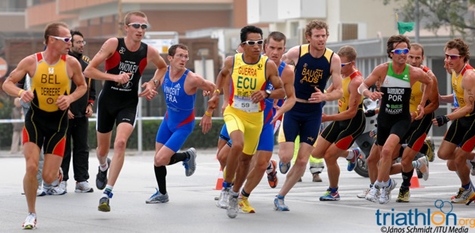 |
Making a Spash - Swimming Basics,by Mike Kelly |
|
Swimming Basics
Swimming as a form of exercise is a great way to stay healthy. Every day people of all ages, immerse themselves in pools, lakes, rivers and oceans. Whether it is for recreation or for fitness training, swimming provides a multitude of benefits to one's health. It is considered a low impact activity and provides an alternative to people who can no longer endure the joint stress and high impact of activities such as running. There are some things to consider before getting started with a swimming routine. If you are just beginning to include swimming as part of your conditioning regime, it is advisable to consult your physician and clarify any medical issues that could effect you.
Planning and Objectives.Consideration should be given to issues involving planning and the setting of goals. It has been quoted "those who fail to plan, plan to fail". Make time to list your objectives and give thought to a training schedule. Most health experts suggest working out at least 3-5 times per week, for 30-60 minutes per workout. Obviously, these are recommendations for "average" folks like you and me. Many of the elite swimmers we see on TV can spend an average of 5+ hours per day in the water, covering distances of 10-13 miles per day.
Where to Swim.Once you have identified your objectives and determined a workout schedule, the next important step is to locate where you are going to workout. The obvious choice for the majority of us is to locate our local swimming pool, although lakes, and oceans are alternative options. Most communities have a pool available for training. Check for pools at your local YMCA, high school, health club or community recreation centers. Find a Pool
Swimming Gear
What Will I Need to Bring.Once you have determined where you are going to train, you must now prepare to get ready for your first workout. Here is a list of needed items that I distribute to my athletes prior to the start of the season:
The above items are the basic items needed to participate in practice. Items like kickboards, fins, and pull buoys may be available. Some items may be limited, so if you have your own equipment and wish to bring it to practice, you may do so.
Swimsuits.When determining what swim suit to wear during training, I recommend that you select something comfortable and resistant to the harsh effects of pool chemistry. There are numerous companies that manufacture suitable training suits. Women's suit designs are universal, although women now have an option for a bikini style training suit. For training purposes, males can select either a brief or jammer suit design. The brief is a traditional design offering minimal coverage, while the jammer design covers from the waist down to just above the knees. I suggest that guys avoid wearing board shorts for training purposes, as they increase drag and force you to expend more energy. Changes in competitive suit design have become very high tech, as well as controversial. In a future article, I hope to discuss changes in swim suit design and manufacturing.
Goggles.Goggles are not mandatory for swim training, although they definitely make a difference in getting through your training. Like in the case of swim suits, there are a multitude of designs and manufacturers available. Again, I encourage you to select your goggles based on comfort. Other considerations include pool environment. If training outdoors, you might prefer a goggle with tint in it, likewise, if training indoors, a clear goggle might be preferable. Another option available to you is to have a prescription pair of goggles. The simplest way to avoid your goggles from fogging up is to lick hte insides with your tongue and then rinse out in the water. If this is too rustic for you, there are several varieties of manufactured lens defogger solutions.
Swim Caps.Swim caps come in a variety of colors and styles. A majority of swim caps are manufactured from latex and for a small percentage of the population this presents medical issues. If you have an allergic response to latex, I suggest purchasing a swim cap manufactured with silicon. Although silicon caps are more expensive, they tend to have a better durability factor.
Hydration.Bringing a water bottle to a pool does not make sense to everyone. While working out in the pool, you will experience a loss of fluids that need to be replaced if you wish to train at optimal levels. With dry land activities the loss of fluids through the sweating process is very obvious; this is not the case when in the water. Hydrate yourself before, during and after training. Importance of Hydration
Other Training Equipment.There are several pieces of training equipment that will help you in your overall swim conditioning. The most basic items of equipment are kickboards, pull-bouys and hand paddles. Many pools provide these items for you. I suggest that if you plan on swimming as a serious part of your conditioning, that you purchase these items for yourself. They are all pretty portable items and easily will slip into your backpack or suit case for travel.
Pool Etiquette and Safety
With all the preparations for swim training considered, it's now time to get started. When choosing a lane for working out in, it's best to see if the pool you are using has lane assignments based on a swimmer's skill level. Many pools will have lanes designated with signs that indicate slow, medium, fast. If you are not sure of your skill level, I suggest starting in the slow lane and then reassess your lane position after a few minutes of swimming. Upon making sure that your suit, goggles, cap are all where they are supposed to be, it's time to enter the pool. Unless instructed otherwise, it is recommended you enter the pool feet first. This is good methodology for preventing head injuries or cervical spine trauma. Another good safety practice, as wells good pool etiquette is to make sure that you have clear water in front of you before you jump in. Do not jump directly in front of an approaching swimming. Not only is this disruptive to the athlete in the water, but it can be dangerous and startling.
Swim Warm-up, Workout and Cool Down
Regardless if your a beginning swimmer or a competent swimmer returning from an extended absence from the pool, it's important to start off your training with the expectation of easing into it. After establishing a routine in the first few practices, attempt to build up your total yardage gradually. It is unreasonable to expect to go from 500 yards or meters to 2,000 yards or meters in just one practice. Try to increase your distance gradually on a per workout basis (i.e. add 100 yards/meters a workout). As your yardage increases, you can diversify your workout with stroke drills, challenging sets, etc.
Just as important as your warm-up at the beginning of practice is, it is just as important that you dedicate some time at the conclusion of your practice to a cool down period. Use this time to bring your heart rate down and begin the removal of lactates from your muscles. Post practice is also a good time to incorporate a stretching routine. Another good practice is to shower with soap and wash off any pool chemicals that might have coated your skin. Some athletes are prone to dried out skin from the pool chemicals and may need to use a skin moisturizer.
Like with running, one can choose to train alone. However it is better to train with supervision, a partner or a team. It is not recommended that you swim alone if only from the stand point of safety. If running on land something goes wrong, you still in most cases have a viable source of air to breathe. This is not the case with swimming. Once you slide below the water's surface, you have only minutes to live. Most swimmers tend to be social people and by training with a team you not only get the benefits of a coach, team camaraderie, but you also have a great opportunity for learning from others.
Swimming is an activity that will increase your endurance, help decrease your cholesterol and blood pressure, along with reducing your risk for heart disease, stroke and chronic illnesses. It's a great cross training activity. Although swimming takes a little more effort to participate in, the rewards more than make up for the extra effort.
This being my inaugural contribution to 1Vigor.com, I wanted to start with a basic review of how to get started with your swimming. For some of you reading this, you might find yourself much further along in the process of training. In the weeks to come, I will be covering all of the swim strokes, along with drills, training strategies and ideas to help you improve, as well as enjoy your swimming. There will also be attention given to some of the current trends in swimming and how they may affect you.
Mike Kelly was a High School All-American in 9 different swimming events and was on the University of Southern California Swim Team where he competed all four years at the Pac-10 and NCAA National Championships. Mike currently is Head Coach of the Gig Harbor High School Boys and Girls Swim & Dive Teams and Girls Water Polo and is head of the Washington Interscholastic Swim Coaches Association.
<-- back to top



